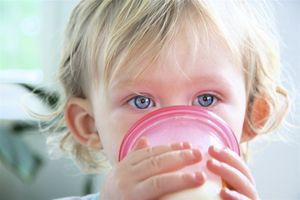
The most common food allergy is milk, which accounts for 98 percent of cases, and it has been found to be the cause of chronic ear infections.
by Dr. Tricia Pingel —
Humans are the only mammal on earth who continue to drink milk past infancy. We consume dairy products on a daily basis, often failing to notice that they are not well tolerated by our bodies, especially those of small children.
Pediatric patients are often seen for ailments and symptoms that are written off by physicians as normal. Ear and throat infections, frequent colds, severe bloating, gas, rashes and colic are some of these symptoms. Bouncing babies up and down or putting them on antibiotics is a common solution, but it may not be the best way to treat these little ones.
Babies who suffer from chronic ear infections usually begin displaying symptoms by the age of one. They are most often placed on antibiotics to fight the bug that is causing the infection, but these antibiotics also kill flora in the stomach that are essential for digestion and health. A pediatric patient suffering from chronic ear infections will experience symptoms repeatedly over a couple of years, with doctors failing to cure the problem. Many times, a solution is to place tubes in the child’s ear. It usually gets to this point before a frustrated parent begins to seek alternative solutions.
Allergens may be the root of the problem. To test for allergies, children are often given Immunoglobin E (IgE) — allergy tests in which the skin is poked to find immediate hypersensitivity allergies. This test, however, fails to detect food allergies, which are slowly mediated.
The most common food allergy is milk, which accounts for 98 percent of cases, and it has been found to be the cause of chronic ear infections. The first signs of a dairy allergy are colic, rashes, and severe gas and bloating. If undiscovered, milk allergies will lead to frequent colds, chronic ear and throat infections and, later in life, asthma. Sometimes a pattern is detected in people who develop asthma, strep throat, frequent headaches, gall bladder issues or diverticulitis later in life — they usually suffered from chronic ear infections as babies.
Ear infections usually begin to occur chronically around age one, when the child is taken off mother’s milk and given dairy products. Detecting a dairy allergy involves a physician sitting down with the parents and discussing what the child has been eating. Usually dairy has been involved. The child is then taken off dairy products and given probiotics to restore healthy stomach flora. Improvement is usually seen in as few as two weeks.
Having a dairy allergy is different from being lactose intolerant. A dairy allergy begins at birth, perhaps being passed down from the mother through antibodies, while lactose intolerance occurs later in life. Lactose intolerance is actually a deficiency in the enzyme used to break down dairy products, and is not an actual food allergy.
As a healthy substitute for dairy, parents may want to try rice or almond milk (make sure to test the child for almond allergy first). If a child never gets the chance to become accustomed to consuming dairy products, then he or she will not crave them.
Finding the root of the problem, which may be as simple as eliminating dairy from the diet, can save a child from unnecessary surgery, illness and complications later in life.
Dr. Tricia Pingel is a naturopathic medical doctor located in Scottsdale, Ariz. She treats menopausal symptoms with bio-identical hormone replacement, infertility, thyroid disorders, anxiety/depression, gastrointestinal concerns, food allergies, celiac disease, IBD and more. www.drpingel.com.
Reprinted from AzNetNews, Volume 30, Number 5, Oct/Nov 2011.





February 23, 2012
Allergies, Asthma, Children and Teens, Health, Infants, Inflammation